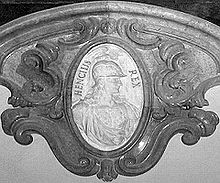Enzio of Sardinia
Enzio (Italian Enzo for Heinz , * around 1220 ; † March 14, 1272 in Bologna ) was king of Sardinia from 1239 to 1249 (titular king until 1272). He was an illegitimate son of Emperor Frederick II and the Swabian noblewoman Adelheid, probably from the house of the dukes of Urslingen .
Youth and military experience
He was a favorite of his father, to whom, according to some sources, he is said to have been very similar in appearance and character, and with whom he shared a love of poetry. Knighted by Frederick II in 1238, he married Adelasia de Lacon-Gunale (* around 1207, † 1255), judge ( Iudicessa ) of Torres (north-west Sardinia ), daughter of the judge Mariano II of Torres and the Agnes de (Lacon-) Massa, and widow of the judge of Gallura (north-east Sardinia), Ubaldo Visconti. In 1246 this marriage was divorced again at Adelasia's instigation. The island of Sardinia was then divided into four sub-kingdoms ( judicates ), whose rulers the title "iudex", d. H. Judges, led. In fact, however, they held a royal position. Adelasia brought two of the four partial kingdoms into her marriage to Enzio. In 1239 Enzio was appointed King of Sardinia and general legate in central and northern Italy by his father. In this function he led military operations against the rebellious Guelphs in Romagna , Marche and Tuscany .
He prepared the capture of high ecclesiastical dignitaries by Gregory IX. were called to a council in Rome to excommunicate Frederick II. The actual military operation at the sea battle of Giglio was not led by him, but by an imperial admiral who intercepted those Genoese ships off the island of Giglio in 1241 , on which bishops and cardinals from all over Europe were. Together with Ezzelino da Romano , he then fought in northern Italy against the Guelfi communities. Captured by the Milanese at Gorgonzola in 1245, he was immediately exchanged for prisoners. In 1247 he took part in the hapless siege of Parma . During this time (1247/48) he made his second marriage to Baroness von Enne (di Egna), a daughter of Henricus III, Podestà of Verona and niece of Ezzelino da Romano.
Capture and imprisonment
A few months after his second marriage, on May 26, 1249, after the battle of Fossalta near Modena , he was taken prisoner in Bologna along with numerous Germans and Cremonese . Although Frederick II demanded his immediate release, the Bologna commune decided to detain Enzio until his death, as a living symbol of the city's pride.
Enzio then lived for more than 22 years in knightly imprisonment in that "Palazzo Nuovo" of the commune, which is still called Palazzo Re Enzo after him . Here he meditated in melancholy verses in the style of the Scuola poetica siciliana ( Sicilian school of poets ) on his own tragic fate and the downfall of his house. He two are odes , a well-known sonnet ( "Tempo che vein sale chi disc end») and a fragment obtained.
Enzio was buried in the left transverse arm of the Basilica di San Domenico in Bologna.
Literary afterlife
Enzio's grave inscription comes from the famous Magister of the Ars Notaria, Rolandino de 'Passeggeri, to whom the author of the proud letter from the Bolognese to Frederick II was erroneously ascribed, in which the emperor was denied the release of his son.
The figure of the unhappy young ruler, whose bravery, education and fair-haired beauty were praised by everyone, inspired Giovanni Pascoli to write his “Canzoni di re Enzio” (1909).
The friend and future husband of the main character Veronica in Gertrud von le Forts' novels The Veil of Veronica and The Wreath of Angels is called King Enzio .
Descendants
There is no evidence that Enzio left any legitimate offspring. In his will he mentions a daughter named Elena (as the daughter of a certain Frascha) who married the Pisan Guelfo della Gherardesca and had several children with him. Furthermore, the two daughters Magdalena and Costanza are mentioned in Enzio's will, but without naming the mother. Evidence of other offspring, e.g. B. a supposed son named Heinrich, are speculative. The story of an alleged son named Bentivoglio, to whom the Bolognese family of the same name later referred, can be assigned to the area of legend.
literature
- Hans Martin Schaller: Enzio. In: New German Biography (NDB). Volume 4, Duncker & Humblot, Berlin 1959, ISBN 3-428-00185-0 , p. 541 f. ( Digitized version ).
- Christian Sperle: King Enzo of Sardinia and Frederick of Antioch. Two illegitimate sons of Emperor Frederick II and their role in the administration of the Regnum Italiae. Peter Lang, Frankfurt am Main 2001, ISBN 3-631-37457-7 .
- Ernst Münch : King Enzius. Contribution to the history of the Hohenstaufen . Nast, Ludwigsburg 1828 ( online ); revised new edition under the title King Enzio . Nast, Stuttgart 1841.
Individual evidence
- ↑ Archived copy ( memento of the original dated December 19, 2018 in the Internet Archive ) Info: The archive link was inserted automatically and has not yet been checked. Please check the original and archive link according to the instructions and then remove this notice.
Web links
| personal data | |
|---|---|
| SURNAME | Enzio of Sardinia |
| BRIEF DESCRIPTION | King of Sardinia |
| DATE OF BIRTH | around 1220 |
| DATE OF DEATH | March 14, 1272 |
| Place of death | Bologna |


